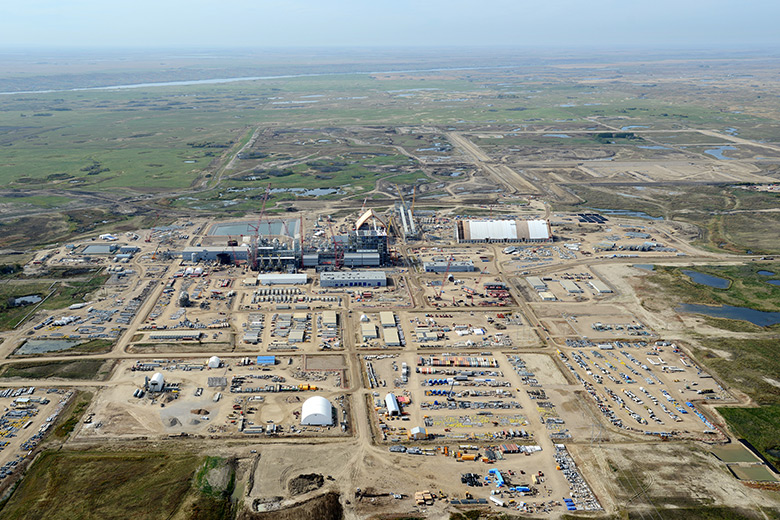Work Advancing on Legacy Project Mine Site, Rail Connections and Shipping Facilities

The legacy is growing. Construction at K+S Potash Canada’s (KSPC) $4.1 billion Legacy Project in southern Saskatchewan is about 50 percent completed. Beyond the mine site, workers with heavy equipment are moving massive amounts of earth in preparation for a new rail line that will transport potash from the Legacy Project mine site to the world. And at Port Moody in British Columbia, construction has begun on the world’s most modern potash handling facility at Pacific Coast Terminals’ (PCT) bulk handling operation, where Legacy potash will be stored and loaded onto ships bound for K+S Group’s international clients.
Kevin Brown, Project Director for Amec Foster Wheeler, the contractor in charge of construction at the Legacy Project mine site, says: “We’re making solid progress and we’re rapidly approaching the peak of our construction program.’’
Brown says about 2,000 people including KSPC’s operations team are working daily on site and that number will swell to about 2,400 when the construction program peaks later this fall. The Legacy Project mine site, located about 20 km southwest of Bethune, SK, is scheduled to start commissioning in the summer of 2016.
Structural steelwork underway throughout the process plant remains the centerpiece of the construction program, says Brown. Eleven of fourteen mammoth processing vessels delivered by special trucking units or assembled on-site now reside in their appropriate spots in the plant. The remaining three will soon be in place. Brown says that when the steelwork is finished in a particular section of the plant, the cladding contractor moves in to close the area to the elements and other workers install the mechanical, piping, and electrical equipment required to operate the facility. Electrical rooms that will power the plant were modularized off-site, as were 71 pipe rack modules and 44 conveyor gallery modules.
“All this work has to be closely coordinated with the steel program so we’re never putting workers in harm’s way,’’ says Brown. “For example, we can’t have workers under those cranes as they’re operating.’’
Elsewhere on site, the administration and maintenance buildings are taking shape and the structures for two product warehouses capable of storing 100,000 and 40,000 tonnes of potash respectively are approaching completion. The massive “glulam’’ wooden arches supporting the roofs of the warehouses may look out of place in an industrial setting, but Brown says they’re used here because wood is not susceptible to the corrosive environment created by potash products. Earth leveling work is underway for KSPC’s 14 km rail line with a loop at the plant and 5 km of spur line and Canadian Pacific (CP)’s approximately 19 km of rail and spur line infrastructure that will connect the mine to CP’s existing trackage at Belle Plaine, SK. And at PCT’s bulk handling facility at Port Moody, construction is underway on a railcar unloading building and potash storage warehouse, as well as on upgrades to the water treatment facilities and ship-loading equipment. All work is scheduled for completion next year.
All aspects of the Legacy Project will accumulate to the well-known $4.1 billion CAD investment. Dr. Gerd Dalhoff, Vice President of Controls at KSPC and one of the three managers in charge of overseeing the Legacy Project, never gets tired of making clear that there is no dollar or minute to spare.
“KSPC has formed integrated teams with both Amec Foster Wheeler for the Legacy Project and contractor CH2MHILL for the Potash Handling Facility in Vancouver. Together, these teams work to ensure that we are on track to achieve our main goals, the first being to commission the plant in 2016 while maintaining our budget,” says Dahlhoff. “Our discipline to stick to our plan will take us there.”
In the wellfield several kilometers east of the plant, well pads No. 4 and No. 5 have been “handed over’’ to operations for the initiation of cavern development processes. The 18 caverns beneath well-pads No. 2 and No. 3, where early cavern development began in March, will supply the initial feed to the processing plant when the mine goes into production.
“We need to have those first 18 caverns in place for a startup,’’ says Sam Farris, Vice President and General Manager of Operations at KSPC. “And it takes about a year to fully develop a cavern for potash production.’’ The Legacy Project is expected to reach 2.0 million tonnes of production capacity by the end of 2017, says Farris.
However, Farris’ biggest job right now is preparing the organization for the process plant startup and early operation.
“It’s a big project requiring more than 200,000 person-hours of work,’’ says Farris, adding the work involves hiring, planning, and a lot of training. “The time needed to develop and deliver training alone will be about 100,000 person-hours.’’
